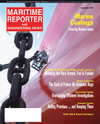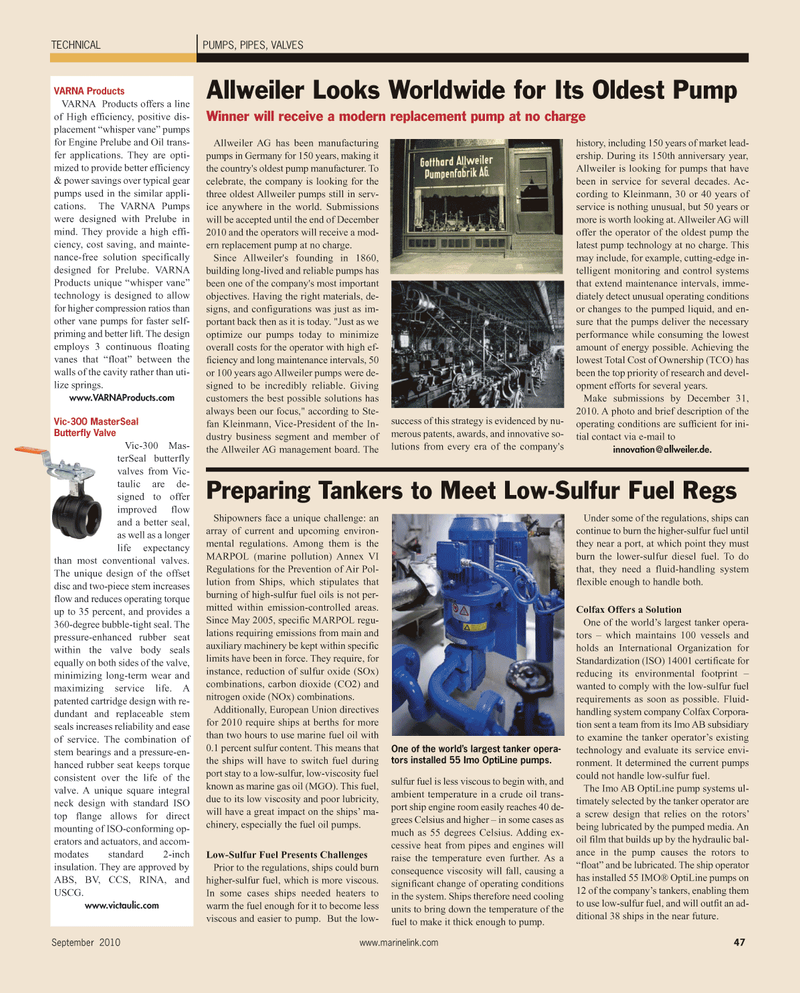
Page 47: of Maritime Reporter Magazine (September 2010)
Marine Propulsion Edition
Read this page in Pdf, Flash or Html5 edition of September 2010 Maritime Reporter Magazine
September 2010 www.marinelink.com 47
TECHNICAL PUMPS, PIPES, VALVES
Shipowners face a unique challenge: an array of current and upcoming environ- mental regulations. Among them is the
MARPOL (marine pollution) Annex VI
Regulations for the Prevention of Air Pol- lution from Ships, which stipulates that burning of high-sulfur fuel oils is not per- mitted within emission-controlled areas.
Since May 2005, specific MARPOL regu- lations requiring emissions from main and auxiliary machinery be kept within specific limits have been in force. They require, for instance, reduction of sulfur oxide (SOx) combinations, carbon dioxide (CO2) and nitrogen oxide (NOx) combinations.
Additionally, European Union directives for 2010 require ships at berths for more than two hours to use marine fuel oil with 0.1 percent sulfur content. This means that the ships will have to switch fuel during port stay to a low-sulfur, low-viscosity fuel known as marine gas oil (MGO). This fuel, due to its low viscosity and poor lubricity, will have a great impact on the ships’ ma- chinery, especially the fuel oil pumps.
Low-Sulfur Fuel Presents Challenges
Prior to the regulations, ships could burn higher-sulfur fuel, which is more viscous.
In some cases ships needed heaters to warm the fuel enough for it to become less viscous and easier to pump. But the low- sulfur fuel is less viscous to begin with, and ambient temperature in a crude oil trans- port ship engine room easily reaches 40 de- grees Celsius and higher – in some cases as much as 55 degrees Celsius. Adding ex- cessive heat from pipes and engines will raise the temperature even further. As a consequence viscosity will fall, causing a significant change of operating conditions in the system. Ships therefore need cooling units to bring down the temperature of the fuel to make it thick enough to pump.
Under some of the regulations, ships can continue to burn the higher-sulfur fuel until they near a port, at which point they must burn the lower-sulfur diesel fuel. To do that, they need a fluid-handling system flexible enough to handle both.
Colfax Offers a Solution
One of the world’s largest tanker opera- tors – which maintains 100 vessels and holds an International Organization for
Standardization (ISO) 14001 certificate for reducing its environmental footprint – wanted to comply with the low-sulfur fuel requirements as soon as possible. Fluid- handling system company Colfax Corpora- tion sent a team from its Imo AB subsidiary to examine the tanker operator’s existing technology and evaluate its service envi- ronment. It determined the current pumps could not handle low-sulfur fuel.
The Imo AB OptiLine pump systems ul- timately selected by the tanker operator are a screw design that relies on the rotors’ being lubricated by the pumped media. An oil film that builds up by the hydraulic bal- ance in the pump causes the rotors to “float” and be lubricated. The ship operator has installed 55 IMO® OptiLine pumps on 12 of the company’s tankers, enabling them to use low-sulfur fuel, and will outfit an ad- ditional 38 ships in the near future.
VARNA Products
VARNA Products offers a line of High efficiency, positive dis- placement “whisper vane” pumps for Engine Prelube and Oil trans- fer applications. They are opti- mized to provide better efficiency & power savings over typical gear pumps used in the similar appli- cations. The VARNA Pumps were designed with Prelube in mind. They provide a high effi- ciency, cost saving, and mainte- nance-free solution specifically designed for Prelube. VARNA
Products unique “whisper vane” technology is designed to allow for higher compression ratios than other vane pumps for faster self- priming and better lift. The design employs 3 continuous floating vanes that “float” between the walls of the cavity rather than uti- lize springs. www.VARNAProducts.com
Vic-300 MasterSeal
Butterfly Valve
Vic-300 Mas- terSeal butterfly valves from Vic- taulic are de- signed to offer improved flow and a better seal, as well as a longer life expectancy than most conventional valves.
The unique design of the offset disc and two-piece stem increases flow and reduces operating torque up to 35 percent, and provides a 360-degree bubble-tight seal. The pressure-enhanced rubber seat within the valve body seals equally on both sides of the valve, minimizing long-term wear and maximizing service life. A patented cartridge design with re- dundant and replaceable stem seals increases reliability and ease of service. The combination of stem bearings and a pressure-en- hanced rubber seat keeps torque consistent over the life of the valve. A unique square integral neck design with standard ISO top flange allows for direct mounting of ISO-conforming op- erators and actuators, and accom- modates standard 2-inch insulation. They are approved by
ABS, BV, CCS, RINA, and
USCG. www.victaulic.com
Allweiler AG has been manufacturing pumps in Germany for 150 years, making it the country's oldest pump manufacturer. To celebrate, the company is looking for the three oldest Allweiler pumps still in serv- ice anywhere in the world. Submissions will be accepted until the end of December 2010 and the operators will receive a mod- ern replacement pump at no charge.
Since Allweiler's founding in 1860, building long-lived and reliable pumps has been one of the company's most important objectives. Having the right materials, de- signs, and configurations was just as im- portant back then as it is today. "Just as we optimize our pumps today to minimize overall costs for the operator with high ef- ficiency and long maintenance intervals, 50 or 100 years ago Allweiler pumps were de- signed to be incredibly reliable. Giving customers the best possible solutions has always been our focus," according to Ste- fan Kleinmann, Vice-President of the In- dustry business segment and member of the Allweiler AG management board. The success of this strategy is evidenced by nu- merous patents, awards, and innovative so- lutions from every era of the company's history, including 150 years of market lead- ership. During its 150th anniversary year,
Allweiler is looking for pumps that have been in service for several decades. Ac- cording to Kleinmann, 30 or 40 years of service is nothing unusual, but 50 years or more is worth looking at. Allweiler AG will offer the operator of the oldest pump the latest pump technology at no charge. This may include, for example, cutting-edge in- telligent monitoring and control systems that extend maintenance intervals, imme- diately detect unusual operating conditions or changes to the pumped liquid, and en- sure that the pumps deliver the necessary performance while consuming the lowest amount of energy possible. Achieving the lowest Total Cost of Ownership (TCO) has been the top priority of research and devel- opment efforts for several years.
Make submissions by December 31, 2010. A photo and brief description of the operating conditions are sufficient for ini- tial contact via e-mail to [email protected].
Allweiler Looks Worldwide for Its Oldest Pump
Winner will receive a modern replacement pump at no charge
Preparing Tankers to Meet Low-Sulfur Fuel Regs
One of the world’s largest tanker opera- tors installed 55 Imo OptiLine pumps.

 46
46

 48
48
